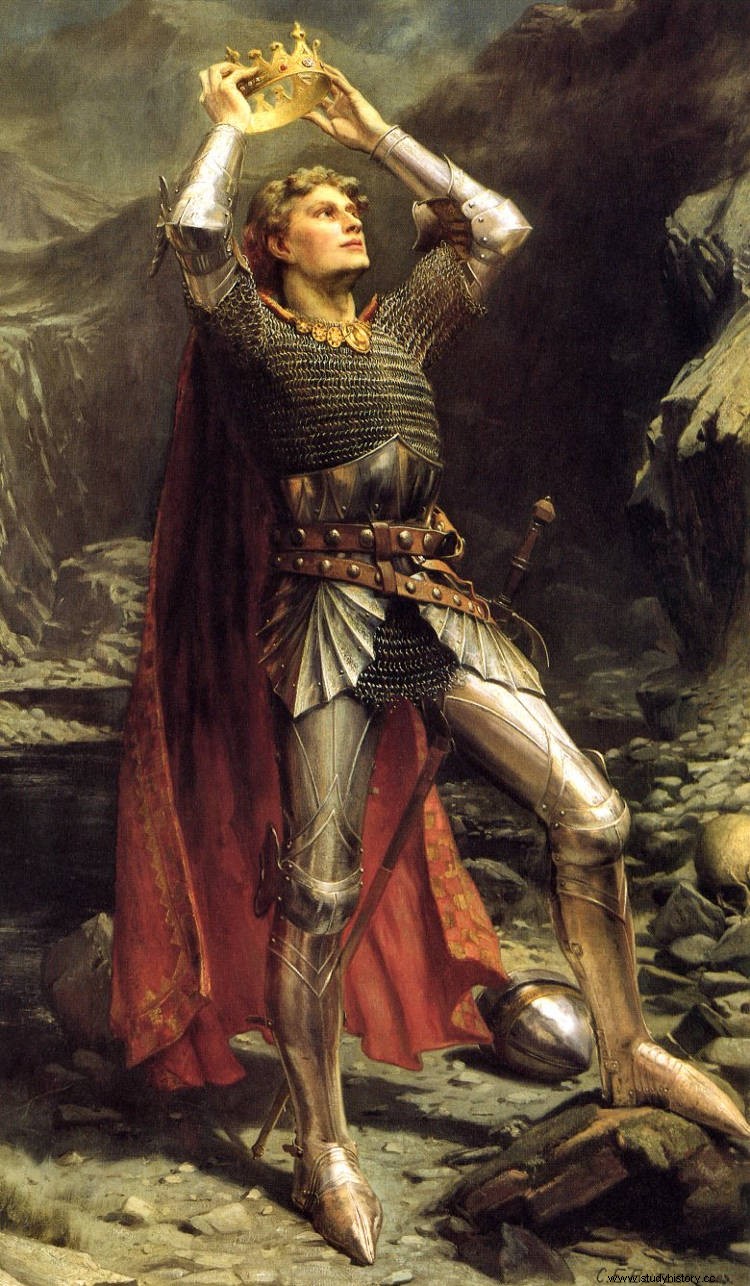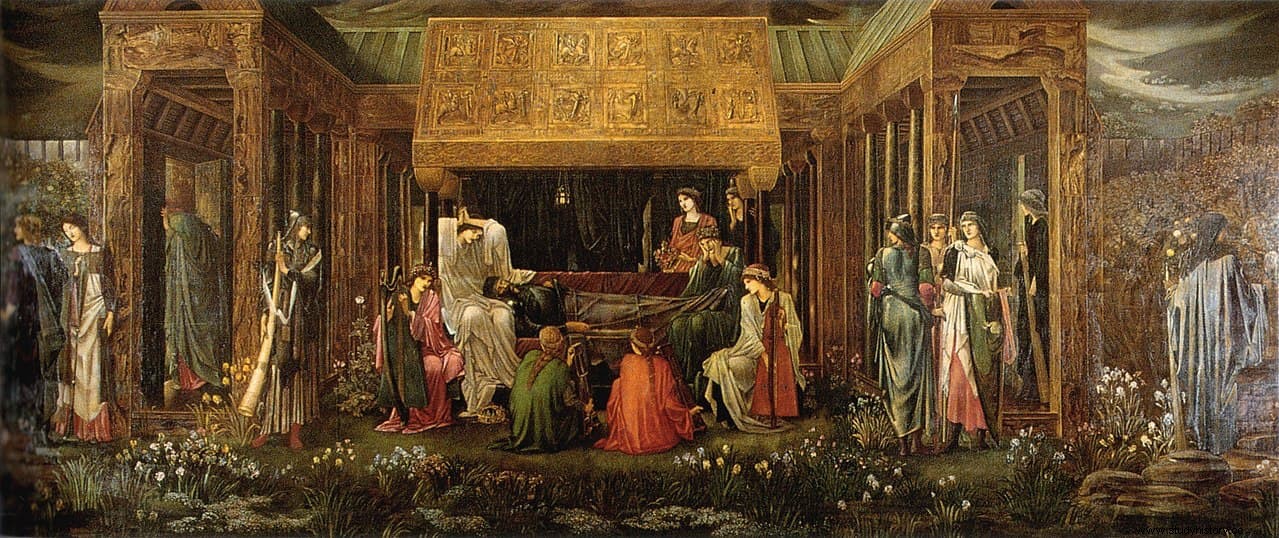There are some swords that have gone down in history with their own name, in the case of the two of the Cid (Tizona and Laundry ), the Joyeuse of Charlemagne, the Durendal of Roldán or the Zulfiqar of Ali (the son-in-law of Mohammed), among others. But if there is one that is universally known, it is Excalibur , the weapon that made Arthur Pendragon king of England by removing it from the rock in which it was embedded and which, however, is also the least historic of all. Let's see some curiosities about her and everything that surrounds her.

Obviously, for this it would be necessary to clarify how much is true and how much is legendary in the figure of its owner. As we said in our article on the Battle of Mount Badon, Arthur is probably a character based on a soldier (or several) from the late-Roman period who became a local chieftain when Rome abandoned the British Isles in the 5th century, leaving them helpless before barbarian invasions. From there, reality and myth merge, being very difficult to separate them.
Historiographic sources do not help much. The main ones are De Excidio et Conquestu Britanniae (On the ruin and conquest of Britain), a kind of critical sermon written by a religious named Gildas; the History Brittonum (History of the Britons), anonymous although some attribute it to the Welsh monk Nennio; and the Historia Regum Britanniae (History of the Kings of Britain), whose author was also a clergyman, Geoffrey of Monmouth. All three speak of Arturo as a real character, although it must be taken into account that, except for De Excidio , they are several hundred years later and, true to their time, have a style that combines the true with the fantastic.
Excalibur it appears obliquely in Godofredo de Monmouth's text, which is the one that introduces other references that are familiar to us today, in the case of his forge in Avalon or the character of Merlin, for example. But he does not do it with that name, which is Welsh, but with the Latinized Caliburnus ; indeed, it is the first non-Welsh source to do so. The etymology of Caliburnus is not entirely clear. It probably comes from caledfwlch , which in turn would come from the Breton kaledvoulc’h , allusion to the name Caledfwlch with which the sword appeared in the ancient narrative Culhwch and Olwen in the hands of Llenlleawg (Lancelot, Lancelot), a warrior of Arthur who wielded it to kill the Irish king Diwrnach and steal the magic cauldron from him.

In turn the name Caledfwlch derived from the Gaelic Caladbolg , which applied to a sword that, like the previous one, possessed extraordinary power and whose possession was attributed to various heroic figures in Irish mythology. This was the case of Fergus mac Róich, a character from the Ulster Cycle (an anthology of stories in prose and verse about ulaid heroes, whose main protagonist is Cú Chulainn). The Arthurian legend could have drunk from these stories or, at least, simultaneously emerged and assimilated the figure of the weapon.
However, the name Caliburnus evolved into Caliburn and its various variants (Calabrum, Callibourc, Chalabrun, Calabrun, Chalabrum, Calibore, Callibor, Caliborne and Calliborc ) finally remaining in Escaliborc and then Escalibor, Excalibor and finally Excalibur . Something that is clear in French sources such as the Lestoire des Engles Godofredo Gaimar or in the Roman de Brut by the Anglo-Norman poet Wace, both from the 12th century. From that same period is one of the best-known Arthurian narratives, that of Chrétien de Troyes, in which the sword is already called Escalibor . However, at the beginning of the 16th century we still find old names such as the Bewnans Ke (a life of the British Christian saint Saint Kea), where the sword appears as Calesvol .

There is another possibility:the one that places its origin in Latin expressions like chalybis or ex calce liberatus , translatable by steel and freed from the stone respectively. Whatever the answer, we are now going to move on to that second question, that of the stone, which is equally interesting. In the first place, it should be noted that the idea of a weapon stuck in a rock was too obvious and juicy not to be reflected in other legends; thus, in the plural, since Excalibur She is not the only one who went through such a situation. The oldest of which there is news in this sense was the club that Hercules embedded in the ground without anyone being able to remove it except himself (and in doing so, water began to sprout until Lake Vico was formed).

But for the topic at hand, a case that we have already seen right here is more interesting:the sword of San Galgano, which has been preserved in the Italian Rotonda de Montesiepi since the 13th century. It is said that the knight Galgano Guiodotti embedded it in a stone when he was trying to break it to leave his life of adventures and become a hermit. Galgano, later canonized by Pope Urban III, was the model later assimilated by Sir Gáwain, King Arthur's nephew, one of the oldest and most important characters in the Arthurian cycle. Son of a sister of Morgana, therefore cousin of Mordred, he starred in his own myth in Sir Gáwain and the Green Knight , an anonymous fifteenth-century romance. In fact, in early French works, the case of Perceval. The story of the Grail (Chrétien de Troyes) or the Vulgate Cycle (also known as Pseudo-Map Cycle or Lancelot-Grail ), the sword is not wielded by Arthur but by Gáwain.
Likewise, there is another story from the Arthurian cycle with a sword stuck in a stone (or a log, according to another version). It is that of Galahad, the bastard son that Lancelot had with Elaine of Corbenic under a spell that made him think that he was with his mistress, Queen Guinevere. Galahad -Lanzarote's original name- is brought to court by his father and innocently sits at the Round Table in an empty place that is reserved for whoever finds the Holy Grail, a mission that cost the lives of all those who sat. there before.
But he, a paradigm of purity, will succeed in the mission and Arthur takes him to a river where there is a floating stone with an embedded sword and an inscription in which he proclaimed the best knight in the world to whom he could extract it. Galahad did, of course.
The specific mention of an Excalibur freed by the future king she first appears in the tale Merlin , by the French poet Robert de Boron, who lived between the 12th and 13th centuries. He was the one who gave the myth of Arthur a Christian dimension by relating it to the Holy Grail, although in his version the protagonist did not pull it out of a rock but out of an anvil.

The English writer Thomas Malory, in his famous work The Death of Arthur (on which John Boorman was based for his no less famous film Excalibur ), speaks of both elements, an anvil on a stone. Actually, the author collects a second later French version, that of the so-called Post-Vulgate Cycle or Roman du Graal , where Excalibur It no longer arrives in the hands of Arthur, but delivered by Nimue, the Lady of the Lake (a kind of nymph that symbolized the survival of paganism) when he was already king.

Excalibur , like so many other mythological weapons, was not normal but magical. In that he followed an old high medieval tradition in which we find Dyrnwyn , the sword of Rhydderch Hael (a monarch of the northern British kingdom of Alclud), which burned if used by someone unworthy. Or to Claíomh Solais , the Sword of Light from Irish mythology. Arturo himself had a varied panoply in which the spear Ron was counted. (short for Rhongomyniad ), the Carnwennan dagger , which could make its user invisible, and two other swords:Clarent , which reviews the English poem Morte Arthure , and Seure , which the sovereign entrusted to Lancelot.
The magical powers of Excalibur they manifested themselves not only in the fact that it was inserted into a rock (or anvil) nor that it was delivered to its bearer by a nymph, but also that, in the first battle in which Arthur used it after freeing it from its stony prison, it dazzled. to all his enemies (“about thirty torches” , describes Malory).
Curiously, these extraordinary properties extended to its sheath, which had healing powers and that is why in Malory's story it would be stolen by Morgana, Arthur's half-sister, and thrown into a lake to take revenge for the death of her beloved Accolon of Gaul; a momentous act because Arthur will die at the Battle of Camlann, deprived of the ability to heal his wounds. The king was carried dying to Avalon, the legendary island where he had forged Excalibur , which was returned to the Lady of the Lake, thus closing the circle.
Fonts
The Death of Arthur (Sir Thomas Malory)/Merlin and the Grail. Joseph Arimathea, Merlin, Perceval. The trilogy of Arthurian romances (Robert de Boron)/Perceval. The Tale of the Grail (Chrétien de Troyes)/Roman de Brut. Arthurian Chronicles (Wace)/Lancelot-Grail. The post-Vulgate Cycle:the quest of the Holy Grail and the death of Arthur (Norris J. Lacy, ed)/De Excidio et Conquestu Britanniae (Gildas)/History of the Britons (Historia Brittonium) (Nennius)/Regum Britanniae History (Geoffrey of Mounmouth)/History on the edge. Excalibur and the borders of Britain, 1100-1300 (Michelle Warren)/A Brief History of King Arthur (Christopher Hibbert)/The Camelot Project (University of Rochester)/Wikipedia.
